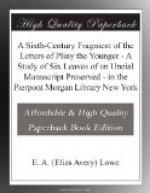[Footnote 22: That the hair side of the vellum retained the ink better than the flesh side may be seen from an examination of facsimiles in the Leyden series Codices graeci et latini photographice depicti.]
[Footnote 23: That the ink could scale off the flesh side of the vellum in less than three centuries is proved by the condition of the famous Tacitus manuscript in Beneventan script in the Laurentian Library. It was written in the eleventh century and shows retouched characters of the thirteenth. See foll. 102, 103 in the facsimile edition in the Leyden series mentioned in the previous note.]
But let us assume, for the sake of argument, that the Morgan fragment is a modern forgery. We are then constrained to credit the forger not only with a knowledge of palaeography which is simply faultless, but, as will be shown in the second part, with a minute acquaintance with the criticism and the history of the text. And this forger did not try to attain fame or academic standing by his nefarious doings, as was the case with the Roman author of the forged “Anonymus Cortesianus,” for nothing was heard of this Morgan fragment till it had reached the library of the American collector. If his motive was monetary gain he chose a long and arduous path to attain it. It is hardly conceivable that he should take the trouble to make all the errors and omissions found in our twelve pages and all the additions and corrections representing different ages, different styles, when less than half the number would have served to give the forged document an air of verisimilitude. The assumption that the Morgan fragment is a forgery thus becomes highly unreasonable. When you add to this the fact that there is nothing in the twelve pages that in any way arouses suspicion, the conclusion is inevitable that the Morgan fragment is a genuine relic of antiquity.
[Sidenote: Archetype]




